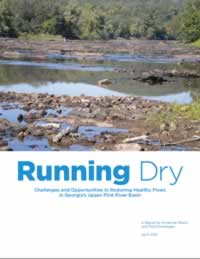Running Dry: Restoring Healthy Flows In Georgia’s Upper Flint River Basin

The upper Flint River of west-central Georgia is a river running dry. While rivers and streams in arid parts of the United States often dry up seasonally, the Southeast has historically been known as a water-rich area with plentiful rainfall, lush landscapes, and perennial streams and rivers. The upper Flint River supports recreation, fisheries, local economies, and threatened and endangered species that all depend on healthy and reliable flows which are becoming increasingly rare.
Examining and addressing low-flow problems in the upper Flint River basin is important for the entire Apalachicola-Chattahoochee-Flint river basin. The Flint also offers examples of what can and likely will happen to more rivers in urbanizing areas and in historically wet regions facing increasing water quantity stress.
What’s wrong in the upper Flint? Recent droughts have reduced popular sections of the river to wide expanses of exposed rock with trickles of water running in between. And, in most summers the river runs lower, and for longer, than it did in the past.
This report seeks to bring greater awareness and understanding to the upper Flint’s low-flow problems, to point the way toward solutions, and to begin productive dialog among all stakeholders in a healthy upper Flint River.
These low-flow problems cannot be attributed to any single factor, but rather to many factors which have come into play over a period of decades. Among these factors are:
- Urbanization and land use change;
- Increased frequency of drought;
- An increase in ponds, lakes and reservoirs of all sizes throughout the tributary stream network;
- Increasing demand on the river system for public water supply; and
- A lack of direct return flows of water withdrawn from the river system.
When droughts arrive, the river has lost its resilience against damaging low flows due to the various different demands on its water. In other words, it is now more vulnerable and delicate in the face of chronically dry weather conditions.
Healthy flows can be restored in the upper Flint River basin, but it will take time and a broad group of stakeholders to leverage such a change. Given the wide range of factors that have led to the upper Flint’s low-flow problems, flow restoration opportunities include the following:
- Expand on the recent work by water providers to find areas of water loss in their systems and implement programs to eliminate leaks;
- Improve water efficiency and conservation, especially with regard to outdoor irrigation in the summer months;
- Employ green stormwater infrastructure to infiltrate more rainwater and restore the natural water cycle;
- Increase the volume of return flows to the river system;
- Explore more potable water reuse in the basin;
- Manage existing reservoirs to better ensure healthy flows downstream.
Taking steps to restore healthy flows can reduce the stress on the river system and enable it to regain some of its natural resilience, better preparing the river for droughts to come and protecting the river for the benefit of communities today and for future generations.
Learn more about the Upper Flint River Working Group and the plans to address these issues through the Upper Flint River Resiliency Action Plan.
